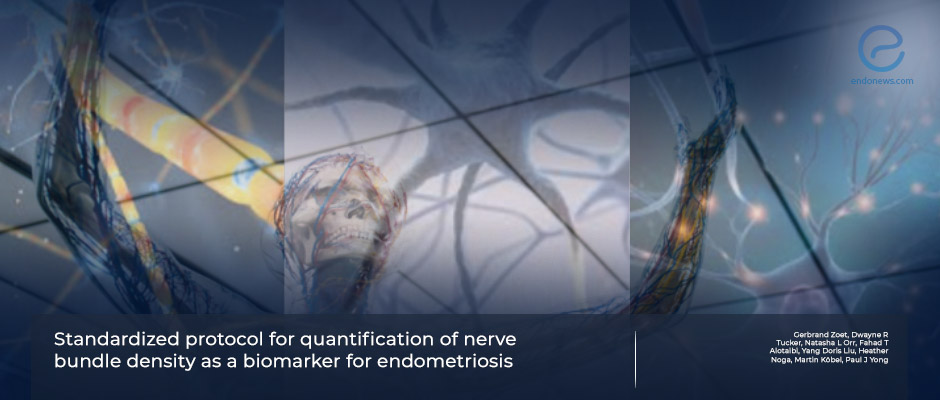Quantification of nerve bundle density as a biomarker for endometriosis utilizing PGP9.5 immunostaining
Jan 2, 2024
Identification of nerve bundles in endometriosis by using Protein gene product
Key Points
Highlights:
- Endometriotic tissues possess nerve fibers taking role in inflammatory processes, leading to increased physical stimuli.
- Furthermore, neuroproliferation or "neurogenesis" may be important as well, so that nerve fibers around endometriotic tissues increase.
Importance:
- Pelvic pain symptoms differ among endometriosis patients and do not correlate well with the revised American Society of Reproductive Medicine staging classification.
- The results of investigations assessing nerve bundles in endometriotic lesions are not comparable due to different methods for measurement.
What’s done here:
- To overcome the obstacles in comparing nerve fiber studies of endometriosis, the authors put forward a standardized protocol for measurement of nerve bundle density.
- This standardization would also be applicable to assess variability in nerve bundle density among patients with endometriosis by anatomic type.
Key results:
- Generalized linear mixed model showed a significant difference in immunohistochemically positive PGP9.5 nerve bundle density between different endometriosis types.
- There were higher densities of PGP9.5 positive nerve bundles in deep and superficial endometriosis in comparison to ovarian endometriomas.
Potential limitations:
- Automated surface area measurement may not be feasible in all samples due to the density of the tissue. This obstacle appeared to be due to fatty tissue in a small minority (5.5%).
- Besides, patient reported outcomes were not included in this prospective cohort study.
Lay Summary
Scientists from Netherlands and Canada have published their authentic study on immunohistochemically assessed nerve fiber bundles of endometriotic tissues in a recent issue of Frontiers in Reproductive Health.
Endometriotic tissues have nerve fibers which are stimulated in inflammatory processes leading to increased physical stimuli. In this context, local neuroproliferation or "neurogenesis" may have a role, as quantitative increase in nerve fibers around endometriotic tissues are shown. However, pelvic pain symptoms are quite different among endometriosis patients so that revised American Society of Reproductive Medicine staging classification can not yield correlations. The results of investigations assessing nerve bundles in endometriotic lesions are not comparable due to different methods for measurement.
In the leadership of Dr.Yong, the authors put forward a standardized protocol for histopathological measurement of nerve bundle density to overcome the obstacles in comparing nerve fiber studies of endometriosis. This standardization would also enable to assess variability in nerve bundle density among patients with endometriosis by type. The authors undertook a prospective cohort study on surgically excised endometriosis tissues in a four year period at a referral center for endometriosis in Canada. A total of 236 tissue samples out of 121 participants were available for nerve bundle assessments. Protein gene product 9.5 (PGP9.5) was used to identify nerve bundles utilizing immunohistochemistry and were counted visually. For nerve bundle density, PGP9.5 nerve bundle count was divided by the tissue surface area for semi-automated measurement.
There were higher densities of PGP9.5 positive nerve bundles in deep and superficial endometriosis in comparison to ovarian endometriomas.
The authors claim that this standardized protocol to measure PGP9.5 positive nerve bundle density by immunohistochemistry in endometritic tissues may serve as a biomarker reflecting local neurogenesis in the endometriosis microenvironment. However, they also advise further studies to externally validate in independent cohorts focusing on the relation between nerve bundle density in different types and anatomic locations of endometriosis, and with symptoms such as pain.
Research Source: https://pubmed.ncbi.nlm.nih.gov/38098984/
nerve fibers endometriosis immunohistochemistry PGP9.5

